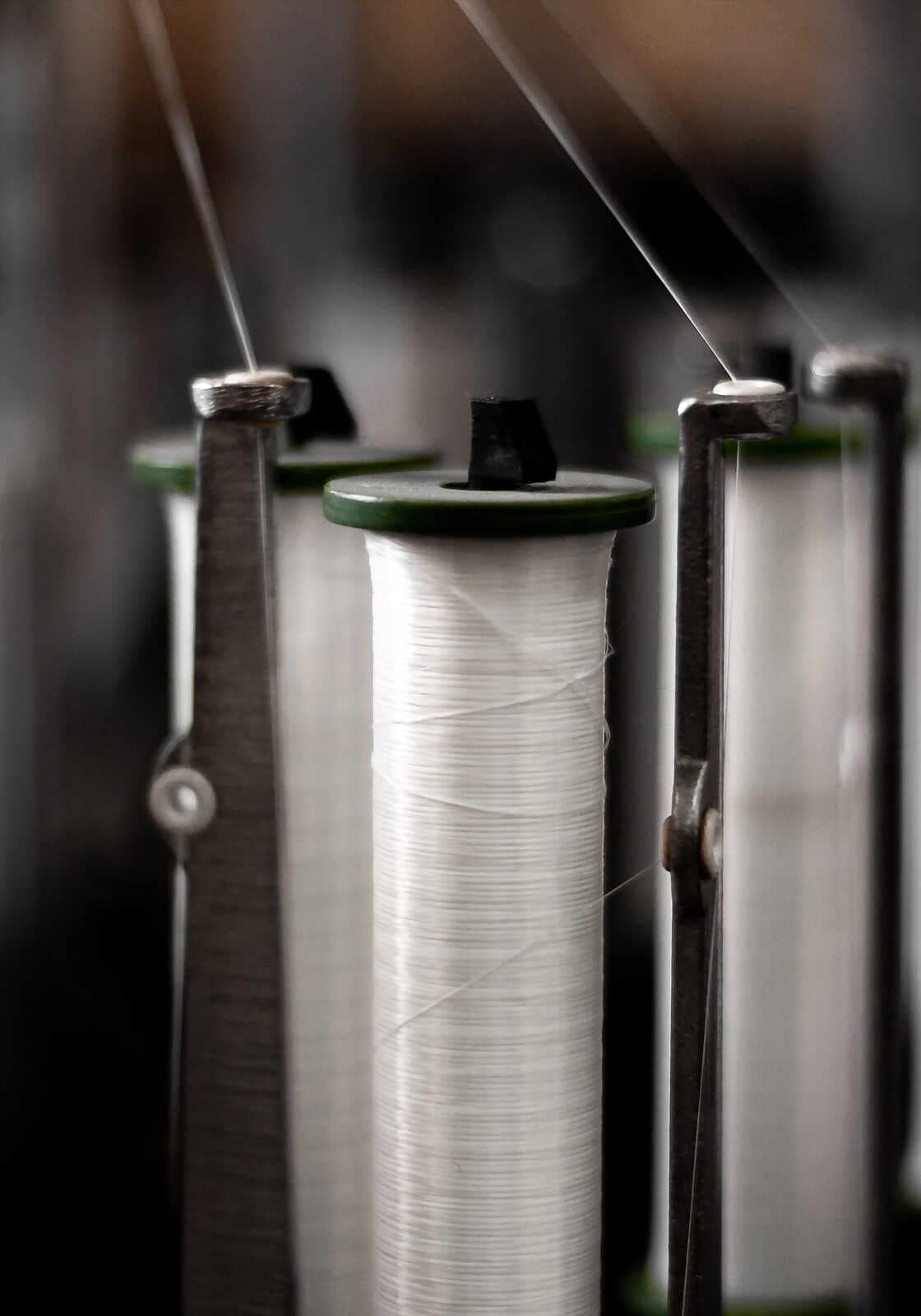Hier finden Sie viele Antworten auf häufig gestellte Fragen. Haben Sie darüber hinaus noch Klärungsbedarf, besondere Wünsche oder benötigen eine individuelle Beratung? Zögern Sie nicht uns anzusprechen.
Wir freuen uns auf Sie.
Wie entsteht ein Geflecht?
Die Klöppel einer Flechtmaschine werden durch in horizontaler Ebene liegende, wellenförmige Gleitbahnen geführt, dass die Fäden der von links nach rechts bewegten Klöppel die Fäden der sich in entgegengesetzter Richtung bewegenden abwechselnd über- und unterflechten. Da nun die Bewegungsrichtung der Klöppel in der Ebene liegt, gleichzeitig aber kontinuierlich das fertige Geflecht nach oben abgezogen wird, so ergibt sich aus diesen zwei divergierenden Bewegungen die diagonale Fadenlage im Geflecht.
Die Lage der im Geflecht von oben links nach unten rechts verlaufenden Fäden (linkes Fadensystem bezeichnet man als Linksgrad, die Lage der Fäden im entgegengesetzten Sinn als Rechtsgrad (rechtes Fadensystem).
Was sind Seile?
Ein Seil wird im allgemeinen wie folgt definiert:
"Biegeschlaffes Maschinenelement zur Übertragung von Zugkräften"
Seile werden nach verschiedenen Kriterien klassifiziert
Nach der Art der Konstruktion
Geschlagene bzw. gedrehte Seile oder geflochtene Seile
Nach dem verwendeten Material
Es wird zwischen Faser- und Drahtseilen unterschieden
Nach dem Verwendungszweck
Hier wird lediglich der Verwendungszweck angegeben
Als Beispiel wären da zu nennen:
Tragseile ; Bergseile ; Abspannseile und dergleichen mehr.
In früheren Zeiten wurden Seile überwiegend aus Naturfasern wie Hanf, Sisal oder ähnlichem hergestellt. Die stetig steigenden Anforderungen in Bezug auf Festigkeit, Elastizität, Gewicht usw. führten dazu, daß der überwiegende Teil der heute gefertigten Seile aus Kunstfaser besteht. Exemplarisch kann man Polyamid; Polypropylen; Dyneema, Polyester und dergleichen mehr als gängige Seilwerkstoffe aufführen.
Was ist ein Geflecht?
Hierunter versteht man ein textiles Erzeugnis, dessen Fäden nicht, wie bei einem Gewebe, senkrecht und waagerecht kreuzen, sondern sie durchziehen das Geflecht in schräger Richtung zu den Warenkanten. Ein Geflecht besteht demnach aus einer Anzahl Fäden, die so zueinander in Beziehung stehen, dass sich ein Teil derselben von links oben nach rechts unten durch das Geflecht zieht, während die anderen Fäden von rechts oben nach links unten verlaufen.
Geflechte werden in unzähligen Bereichen des Lebens, häufig versteckt, verwendet. Um nur einige Beispiele zu nennen: Schnürriemen; Anorakkordeln; Kerzendochte; Gummilitzen; Gürtel; Seile; Wäscheleinen; Nähfäden insbesondere für die Medizintechnik; Medizinische Katheder; Dichtungen; Compositebauteile für die Industrie usw.
Der Verwendungsbereich von Geflechten ist so breit gefächert, es ist nahezu unmöglich alle Anwendungsbereiche zu erfassen.
Was sind Carbonfasern?
Carbonfasern sind industriell hergestellte Fasern aus kohlenstoffhaltigen Materialien, die durch Pyrolyse in graphitartig angeordneten Kohelnstoff umgewandelt werden. Man unterscheidet
isotrope Fasern:
Sie besitzen nur eine geringe Festigkeit und geringere technische Bedeutung
und anisotrope Fasern:
Sie besitzen eine hohe Festigkeit und Steifigkeit bei gleichzeitig geringer Bruchdehnung.
Eigenschaften
Sie sind elektrisch und thermisch sehr gut leitfähig.
Spezifische Wärmekapazität
710 J / (kg – K)
Wärmeleitzahl
17 W / (m – K)
Wärmeausdehnungskoeffizient
- 0,1 (10 – 6 / K)
Spezifischer elektrischer Widerstand
1,6*10-3 Ohm*cm
Was sind Kordeln?
Der Begriff Kordel ist der Oberbegriff für alle in der Flechterei mit zwei gegenläufigen Fadengruppen erzeugten Artikel.
Dabei kann der Querschnitt dieser Artikel quadratisch, rund, oval oder auch trapezförmig sein.
Häufig wird durch einsetzen einer sogenannten "Seele" in die Mitte des Geflechtes dieser Querschnittt ausgefüllt.
Sogenannte Hohlkordeln entstehen auf Rundflechtmaschinen, ohne das eine Seele in der Mitte des Geflechtes zugeführt wird. Das wohl bekannteste Beispiel für eine Hohlkordel ist der Schnürsenkel.
Haben Sie Interesse an einem Termin?
Lassen Sie sich von unseren Experten beraten. Wir stehen Ihnen in allen technischen Belangen zur Seite – von der ersten Idee über die Konzeption bis hin zur Endmontage Ihrer Flechtmaschine.
Steeger Flechtmaschinen
Steeger entwickelt innovative, kundenspezifische Maschinenkonzepte für Flechtmaschinen auf Spitzenniveau. Dabei folgt alles einem Ziel: maximale Leistungsfähigkeit zu erreichen durch maßgeschneiderte Maschinenkonzepte.
Kontakt
Körting Nachfolger
Wilhelm Steeger GmbH & Co. KG
Wittensteinstrasse 208 – 212
42283 Wuppertal, Germany
T + 49 202 25555 – 0
F + 49 202 25555 – 33
E info@steeger-online.de
Rechtliches
©2020 Steeger Flechtmaschinen | All rights reserved




